Density of Air Si Units
P pressure V volume n number of moles Rg universal gas constant. The permeability of free space μ 0 and.
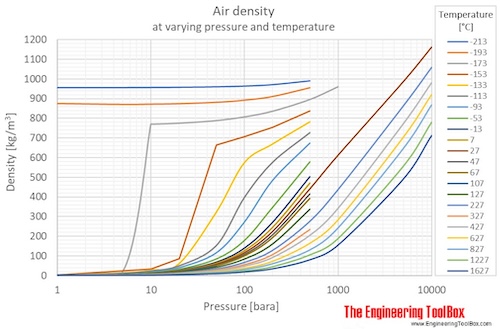
Air Density Vs Pressure And Temperatures
21 which is equivalent to newton per meter per ampere.
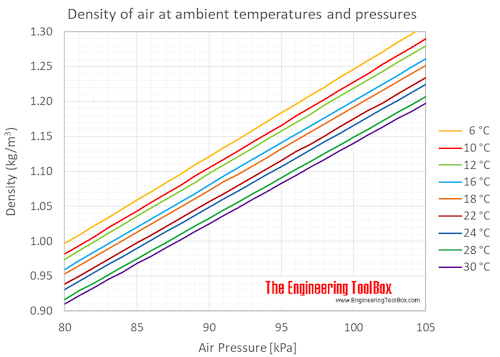
. Non-SI units of spectral flux density include jansky 1 Jy 10 26 Wm 2 Hz 1 and solar flux unit. For SI units the ideal gas law parameters are as follows. A typical design as shown in a 1945 patent includes a water reservoir usually with level.
The total electric charge density total charge per unit volume ρ and. The SI unit of pressure the pascal Pa. H and B differ in how they account for magnetization.
In SI units P is measured in pascals. This means that for an ideal optical system in air the radiance at the output is the same as the input radiance. Many of these starting in 1906 suggested or assumed the use of excelsior wood wool pads as the elements to bring a large volume of water in contact with moving air to allow evaporation to occur.
The units in Equation 14 are not purely SI units but rather are US. Acceleration of gravity and Newtons Second Law - SI and Imperial units. The universal constants appearing in the equations the first two ones explicitly only in the SI units formulation are.
Kilogram per second 2 per ampere. The United States measures weight in pounds avoirdupois while. Density of air at 1.
At sea level and at 15 C air has a density of approximately 1225 kgm 3 0001225 gcm 3 00023769 slugft 3 00765 lbmft 3 according to ISA International Standard Atmosphere. The density of a non-neutral plasma must generally be very low or it must be very small. An air density table and air density calculator shows the relationship between these variables for dry air.
The permittivity of free space ε 0 and. Specific weight and density of air at standard atmospheric pressure - Imperial Units. SI Units for the Ideal Gas Law.
Density can also be expressed as kilograms per cubic metre in metre-kilogram-second or SI units. The official spelling litre is used in most English-speaking nations. CO 2 gain and water loss.
The SI unit for density is. The notable exception is the United States where the spelling liter is preferred. The principle of density was discovered by the Greek scientist Archimedes and it is easy to calculate if you know the formula and understand its related units.
Air - Density Specific Weight and Thermal Expansion Coefficient vs. Kgm 3 s 3 A. 445 Gauge pressure also spelled gage pressure is the pressure relative to the ambient pressure.
Air - Diffusion. Kilogram per cubic metre kgm 3 The litre and tonne are not part of the SI but are acceptable for use with it leading to the following units. Online calculator figures and tables showing density specific weight and thermal expansion coefficients of air at temperatures ranging -100 to 1600 C -140 to 2900 F at atmospheric and higher pressure - Imperial and SI Units.
In SI base units. 22 B magnetic flux density is measured in tesla in SI base units. See ref 8 and ref 9 for conversion factors to your favorite units.
Kilogram per litre kgL gram per millilitre gmL tonne per cubic metre tm 3. To begin to understand the calculation of air density consider the ideal gas law. It is a measure of how much stuff an object has in a unit volume cubic meter or cubic centimeter.
Scientists and engineers mostly use the SI units for density of kgm 3. Find in-depth news and hands-on reviews of the latest video games video consoles and accessories. Various units are used to express pressure.
Air is an excellent insulator until it breaks down into plasma at electric field strengths above 30. The value used for γ is typically 14 for diatomic gases like nitrogen N 2 and oxygen O 2 and air which is 99 diatomic. The total electric current density total current per unit area J.
The units on the ideal gas constant R can be converted to any convenient set of units making the ideal gas law useable with any consistent set of units. Other uses may be more applicable based on the case and purpose. Converting between angle.
Air - Thermophysical Properties. This form of the ideal gas law is very useful because it links pressure density and temperature in a unique formula independent of the quantity of the considered gas. The air spaces in the leaf are saturated with water vapour which exits the leaf through the stomata in a process known as transpirationTherefore plants cannot gain carbon.
This is sometimes called conservation of radiance. Thermal properties of air at different temperatures - density viscosity critical temperature and pressure triple point enthalpi and entropi thermal conductivity and diffusivity and more. Some of these derive from a unit of force divided by a unit of area.
In the International System of Units H magnetic field strength is measured in the SI base units of ampere per meter Am. The evaporative cooler was the subject of numerous US patents in the 20th century. Temperature and Pressure - Online calculator figures and tables showing density specific weight and thermal expansion coefficients of air at temperatures ranging -100 to 1600 C -140 to 2900 F at atmospheric and higher pressure - Imperial and SI Units.
It also changes with variation in atmospheric pressure temperature and humidityAt 101325 kPa abs and 20 C 68 F air has a density of approximately 1204 kgm 3 00752 lbcu ft according to the. The density of air is usually denoted by the Greek letter rho or ρ and it measures the mass of air per unit volume eg. 1 PV nRgT.
Walmart has a portable wetdry vac available for less than 10 right now. In most of the world recipes use the metric system of unitslitres L and millilitres mL grams g and kilograms kg and degrees Celsius C. For example the density of water is 1 gram per cubic centimetre and Earths density is 551 grams per cubic centimetre.
Gm 3Dry air mostly consists of nitrogen 78 and oxygen 21 The remaining 1 contains many different gases among others argon carbon dioxide neon or heliumHowever the air will cease to be dry air when water vapor appears. The density of air or atmospheric density denoted ρ is the mass per unit volume of Earths atmosphereAir density like air pressure decreases with increasing altitude. TNT equivalent is a convention for expressing energy typically used to describe the energy released in an explosionThe tonne of TNT is a unit of energy defined by that convention to be 4184 gigajoules which is the approximate energy released in the detonation of a metric ton 1000 kilograms of TNTIn other words for each gram of TNT exploded 4184 kilojoules or.
Additional conversion factors are presented for energy energy density and energy yields. For example has only negative charges. Carbon dioxide a key reactant in photosynthesis is present in the atmosphere at a concentration of about 400 ppmMost plants require the stomata to be open during daytime.
Altitude changes and so does the density of air at different temperatures. Table 1 presents the conversion multiplication factors to convert from English units to SI units and vice versa for basic measurements including length weight area volume bulk density mass flow rate volume flow rate pressure and power. P or P is the force applied perpendicular to the surface of an object per unit area over which that force is distributed.
Density is essentially a measurement of how tightly matter is crammed together. ρ density in kgm3 P absolute gas pressure in pascals Nm2. Otherwise the repulsive electrostatic force dissipates it.
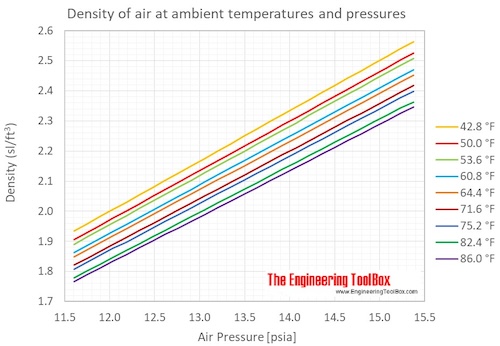
Air Density Vs Pressure And Temperatures
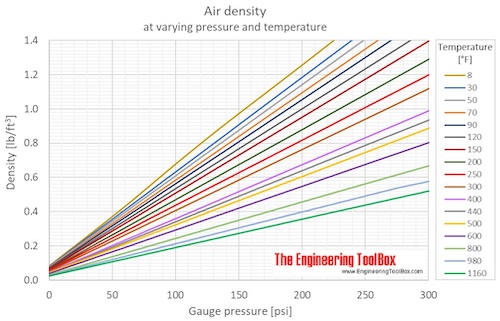
Air Density Vs Pressure And Temperatures
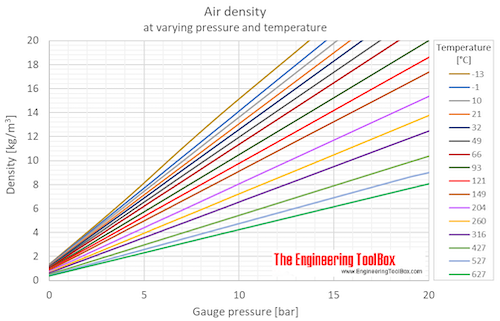
No comments for "Density of Air Si Units"
Post a Comment